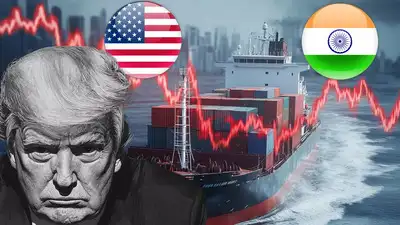Trump’s Trade War Shocks Global Markets: Is India the Least Vulnerable? :
April 5, 2025 : In a move that has sent shockwaves across global markets, US President Donald Trump has announced sweeping reciprocal tariffs on major economies, marking a dramatic escalation in trade tensions. Effective April 5, 2025, the US will impose a flat 10% duty on all imported goods. Just days later, on April 9, the country will transition to a matching tariff system, imposing import duties equivalent to those levied by other nations on American exports.
The implications are staggering. For India, this means a 26% tariff on its goods entering the US, aligning with rates for the EU (20%) and Japan (25%). However, these figures pale in comparison to the steep duties imposed on China (54%), Vietnam (46%), Sri Lanka (44%), and Bangladesh (37%).
As global markets reel from the announcement, a critical question looms: Will Trump’s trade war plunge the world into another recession? And in this unfolding economic uncertainty, where does India stand?
India’s Relative Resilience: Why It May Weather the Storm
While the immediate reaction has been one of panic, India may emerge as one of the least vulnerable economies in this trade war. A recent analysis by economist Niven Winchester, published in The Conversation, evaluates the potential GDP impact of reciprocal tariffs on major economies—including the US itself.
Winchester’s study employs a global trade framework that assesses production, commerce, and consumption patterns to gauge the fallout of escalating tariffs. The first scenario assumes that all major economies retaliate against US tariffs—a likely outcome, given that the EU and Canada (the largest importer of US goods) have already signaled countermeasures.
The GDP Impact: India’s Minimal Exposure
The findings reveal a striking contrast in vulnerability across nations.
| Country | GDP Impact (%) | Annual Household Cost (USD) |
|---|---|---|
| China | -0.82% | $233 |
| Vietnam | -0.71% | $189 |
| Bangladesh | -0.47% | $142 |
| Sri Lanka | -0.39% | $121 |
| EU | -0.25% | $87 |
| Japan | -0.23% | $76 |
| India | -0.19% | $28 |
For India, the projected GDP contraction is a mere 0.19%, translating to an annual cost of $28 per household (approximately ₹2,396 at current exchange rates). This minimal impact stands in stark contrast to China’s 0.82% GDP hit or Vietnam’s 0.71% decline.
Why Is India Less Vulnerable?
Several factors work in India’s favor:
- Lower Export Dependency on the US
Unlike China and Southeast Asian nations, India’s export economy is not overwhelmingly reliant on the US. While the US is a major trading partner, India’s exports are more diversified across the EU, Middle East, and Africa. - Strong Domestic Consumption
India’s economy is driven by domestic demand, which cushions it against external shocks. Unlike export-heavy economies like Vietnam and Bangladesh, India’s growth is less susceptible to global trade disruptions. - Strategic Trade Partnerships
India has been actively strengthening trade ties with alternative markets, including Africa and Latin America, reducing over-dependence on any single economy. - Lower Exposure to High Tariffs
While 26% is steep, it is far below the 54% duty on China or 46% on Vietnam, meaning India’s competitive position in the US market remains relatively stronger.
China’s Misstep and Trump’s Retort
China, facing the highest tariff (54%), has already announced a 34% retaliatory duty on US goods. Trump responded sharply: “China played it wrong, they panicked—the one thing they cannot afford to do!”
This aggressive stance suggests that Beijing may have overplayed its hand, potentially worsening its economic strain. Meanwhile, India’s calibrated approach—avoiding immediate retaliation—could prove advantageous.
The Second Scenario: What If Others Don’t Retaliate?
Winchester also explores a hypothetical scenario where nations do not retaliate—though this is unlikely, given early reactions. Even in this case, India’s GDP impact remains among the lowest.
| Country | GDP Impact (%) |
|---|---|
| China | -0.65% |
| Vietnam | -0.52% |
| India | -0.12% |
The Bigger Picture: Will This Trigger a Global Recession?
While the immediate market reaction has been volatile, a full-blown global recession is not inevitable—but risks are high. The IMF and World Bank have warned that prolonged trade wars could shave 0.5-1% off global GDP.
For India, however, the damage appears contained. The Reserve Bank of India (RBI) may need to adjust monetary policy to support exporters, but the broader economy is unlikely to face severe disruption.
Conclusion: India’s Cautious Optimism
As the world braces for a new era of protectionism, India’s economic structure, domestic demand, and strategic trade policies position it as one of the least vulnerable major economies. While no nation is entirely immune, India’s losses—just ₹2,400 per household annually—are manageable compared to the severe blows faced by China and Southeast Asia.
The coming months will test global resilience, but for now, India may have reason to breathe a little easier.
Trump’s Trade War Shocks Global Markets: Is India the Least Vulnerable?
Trump’s Trade War Shocks Global Markets: Is India the Least Vulnerable?
Trump’s Trade War Shocks Global Markets: Is India the Least Vulnerable?
Trump’s Trade War Shocks Global Markets: Is India the Least Vulnerable?
For the latest news and breaking updates, follow Sejal News Network
“Exciting news! Sejal News Network is now on WhatsApp Channels
Subscribe today by clicking the link and stay updated with the latest news!” Click Here
📰 Latest from Sejal News Network
- Dr. Sarabjit Singh Pays Tribute to Guru Teg Bahadur on 350th Martyrdom Day
- Daily Horoscope for 29 Nov 2025 — Saturday
- Daily Horoscope for 28 Nov 2025 — Friday
Published by Sejal News Network



